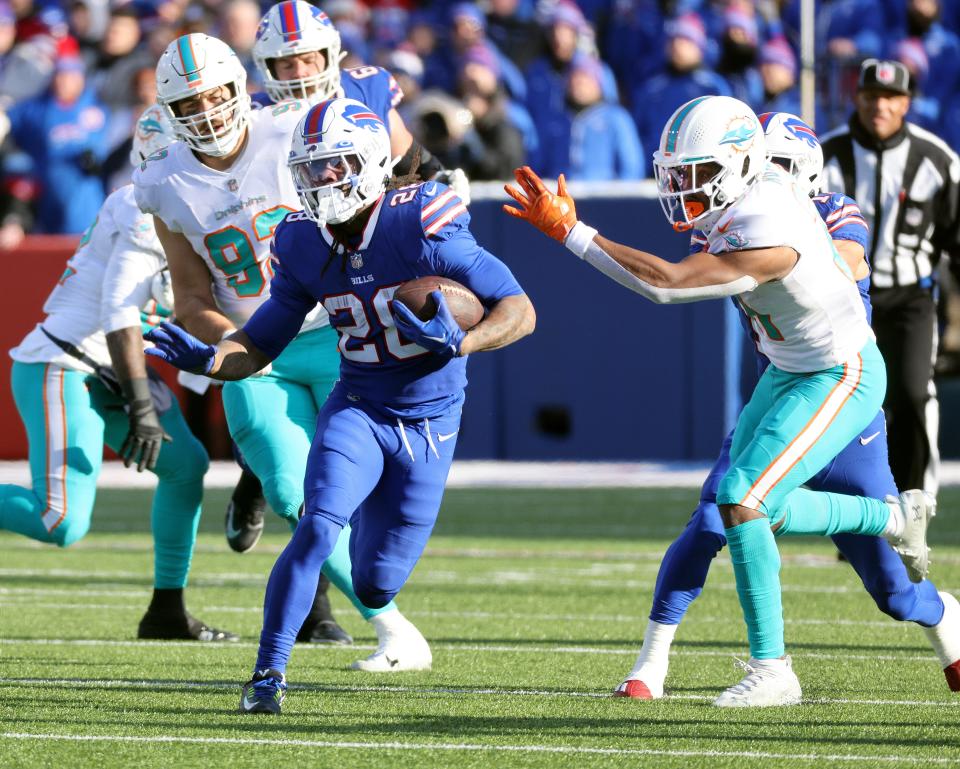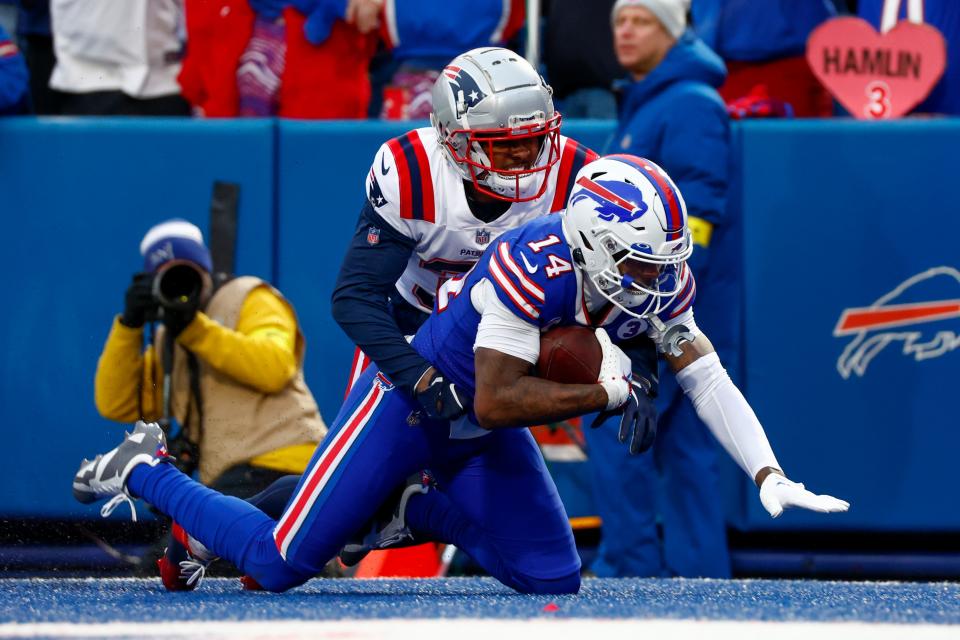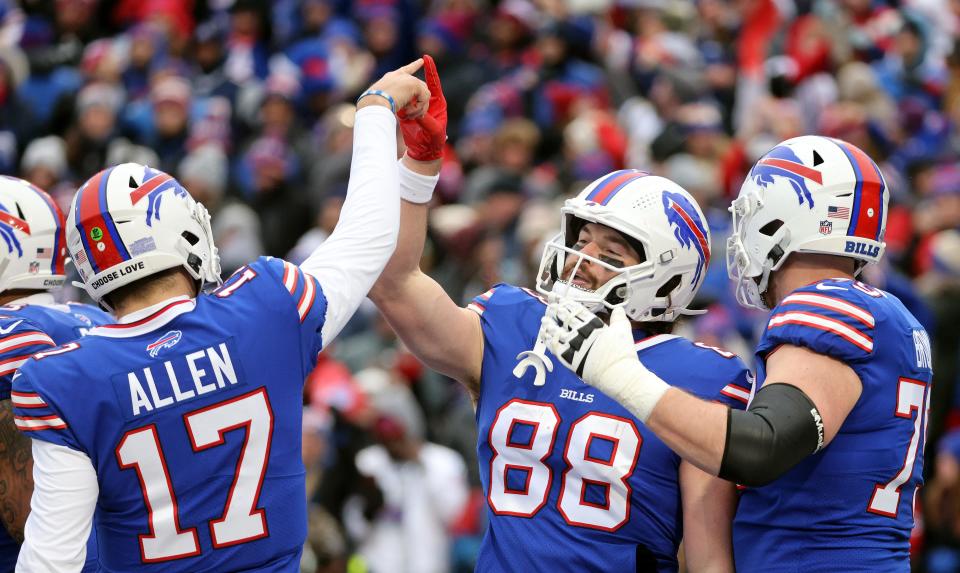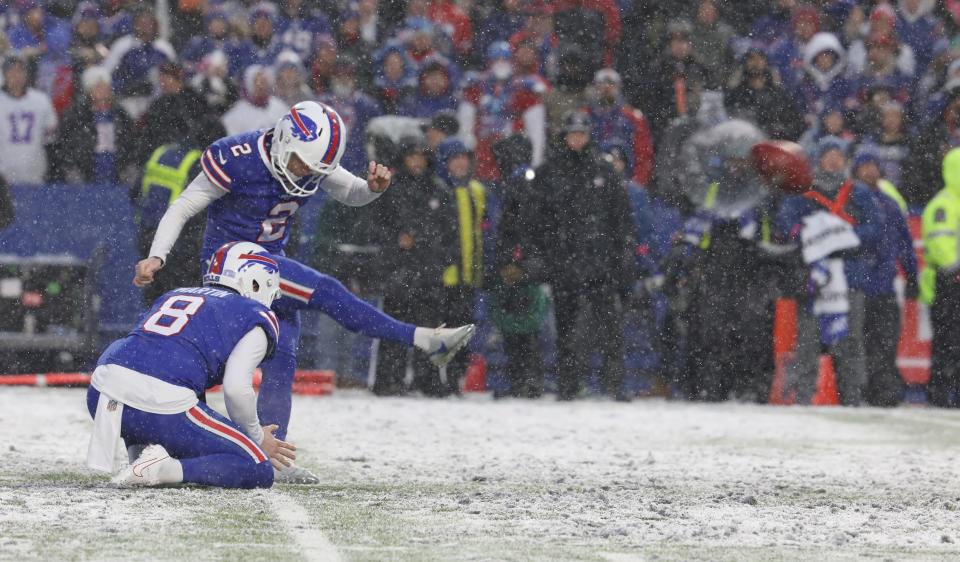Bills 2022 report card: Buffalo had one of best offenses in NFL but flaws were exposed
ORCHARD PARK - We are all guilty at times of recency bias in our lives, and as that pertains to the Buffalo Bills, the last vision we will have of Josh Allen and the offense was their miserable performance in the 27-10 AFC divisional round playoff loss to the Cincinnati Bengals.
“The other day, 10 points is not gonna win many playoff games, most likely,” general manager Brandon Beane acknowledged.
Nope, especially not against Joe Burrow and that dynamic Cincinnati offense. But the stain of that game cannot overshadow the fact that in 2022, Buffalo’s offense, even with some obvious struggles after Allen hurt his elbow in mid-November, and some just as obvious growing pains from first-year coordinator Ken Dorsey, was one of the best in the NFL.
Sign up for the Bills Blast newsletterDelivered straight to your inbox, additional Bills analysis, insight, stats, quotes and team history from Sal Maiorana
The tendency will be to focus on the shortcomings against the Bengals, but that was not what the Bills offense was. It scored at least 30 points in nine of 18 games; it ranked No. 2 in the NFL in points (28.4 per game), yards (397.6), first downs (22.9), yards per play (6.1), yards per drive (39.1), points per drive (2.64), and was No. 1 in third-down conversions (50.2%).
Let me remind everyone of how things used to be in Buffalo: Rob Johnson, Alex Van Pelt, Drew Bledsoe (minus one great half season in 2002), Kelly Holcomb, J.P. Losman, Trent Edwards, Ryan Fitzpatrick (OK, some of that was fun), E.J. Manuel, Kyle Orton and Tyrod Taylor.
The Bills’ average ranking in points from 2001-17 was 19th with a high of seventh in 2004, and the average ranking in yards in that era was 22nd with a high of 12th in 2002, Bledsoe’s first year. So, a little perspective is in order here.
“You don't want to throw out everything we did this season,” Beane said. “We did a lot of good things statistically, and a lot of them were very similar to the previous year (when Brian Daboll was the OC). Unfortunately, we all have a bad taste and the last thing we remember is what happened the other day, which, we definitely didn't get the job done.”
All that said, as you are about to read in my grading of the offensive units, there are certainly things - despite all the gaudy numbers - that need to be addressed. The grades won’t match up to the statistics and that’s because flaws were exposed as the season went on and the offense wasn’t functioning at peak performance near the end of the year as it was far too reliant on Allen to just make things happen.
'We all have to improve': Disappointing ending points to offseason upgrades for Bills
More:Bills reflect on emotional toll of season's unprecedented adversity, early playoff exit
Quarterback: A-

Allen was a thrill ride in his fifth NFL season, but I would guess Beane and coach Sean McDermott would prefer that moving forward, he pumps the brakes a little more often on that runaway rollercoaster. Obviously, he has to be who he is, especially with his scrambling ability and his penchant for throwing the ball downfield. That’s part of why he’s great and the Bills should never muzzle his play-making brilliance.
He ranked second in total first downs produced (passing and rushing) with 246; he was second in combined yards passing and rushing (4,883, which represented 77% of the Bills total yards); third in QB rushing yards (762); seventh in yards passing (4,283); tied for second in TD passes (35); sixth in yards per attempt (7.6); eighth in yards per completion (11.9); and eighth in passer rating (96.6).
According to Pro Football Focus, he led the league in big-time throws (44) which it defines as “a pass with excellent ball location and timing, generally thrown further down the field and/or into a tighter window.”
But Allen needs to realize there’s nothing wrong with taking an easier completion in order to move the chains rather than putting the ball in harms way as often as he did, especially in the second half of the season when it just felt like the offense had to work so hard to move the ball and score. In 2023, the Bills have to find ways to lessen the burden on Allen. His completion percentage (63.3) was exactly the same as 2021, but it ranked 22nd in the NFL.
Allen threw 14 regular-season interceptions, tied for second most, and he also lost five fumbles. There were four more turnovers in the postseason giving him 23 altogether, the most in the NFL in three seasons. The big-time throws were fun, but he also had 29 turnover-worthy plays, defined by PFF as “a pass that has a high percentage chance to be intercepted or a poor job of taking care of the ball and fumbling.” That tied Seattle’s Geno Smith for the most in the NFL.
Running backs: B

The Bills finished seventh in the NFL at 139.5 rushing yards per game and they surpassed 100 yards in all but one regular-season game, but the caveat is always Allen’s yardage which pushes their average up. When it comes to a traditional running game, the Bills haven’t been great, though I thought they were a little better this season once they got rookie James Cook more involved.
Devin Singletary led the team with 819 yards, but his 51.2 average per game ranked 30th and as has been the case all four of his years, he simply lacked that burst to break off big runs. His longest was 33 yards, and he had 21 gains of at least 10 yards which were tied for 19th among RBs. As a receiver, he was average with 38 catches, but his 280 yards and 7.4 average per reception were career bests.
It took time for the Bills to entrust Cook with more playing time and by season’s end he played only 25% of the snaps and out-snapped Singletary only in the season finale against the Patriots. But when he played, Cook made some things happen. He averaged 5.7 yards per carry which was second-best among RBs who played at least 20% of snaps and 12 of his 89 attempts went for 10 yards or more.
What we didn’t see was his pass catching skills which is why the Bills drafted him in the second round. He was supposed to create easy throws for Allen, but he was targeted only 33 times and caught 21 for 180 yards. Those numbers need to increase in 2023, especially with Singletary likely gone in free agency.
Nyheim Hines was acquired at midseason to help the passing game, but that never happened. He hardly ever got on the field except to return kicks. If he’s back, the Bills need to find ways to get him more involved.
Wide receivers: B-

Stefon Diggs was once again an absolute stud. He was third in the NFL in catches (108), fifth in yards (1,429), tied for second in TDs (11), and among WRs targeted at least 100 times, he was fifth in catch percentage (72.5%). However, there was a noticeable drop in production over the second half of the season, primarily because teams began to realize that the Bills didn’t have truly viable secondary options and they really focused their coverage on him whether it was man or zone.
In the first nine games Diggs had 72 catches for 985 yards and seven TDs. In the last nine counting the postseason, he had 36 catches for 444 yards and four TDs, literally half the production. That, in part, led to his angry exit from the stadium Sunday born from a buildup of frustration. Diggs alone is an A for me, but the overall group dragged the grade down.
Gabe Davis looked like a rising star after the playoff loss in Kansas City, but he did not build on that performance. He set career highs with 48 catches for 836 yards and seven TDs, but there was far too much inconsistency in his game as evidenced by his catch percentage of 51.6 which ranked him dead last among 39 WRs who were targeted at least 90 times. And while his 17.4 average per reception was second-best in the league, 11% of his total yardage came on one play (the 98-yard TD against the Steelers), so that skews things quite a bit.
In the slot, the Bills were not able to replace Cole Beasley’s production, not even when they brought Beasley himself back. Isaiah McKenzie had career highs with 42 catches for 423 yards, but he was not a reliable enough target for Allen when things got off script. Rookie Khalil Shakir had some nice moments, but he played only 25% of the snaps. The other slot man, Jamison Crowder, played only four games before getting hurt.
Tight ends: C

Dawson Knox was given a hefty contract extension during training camp and then went out and failed to match his production from 2021. He caught one less pass (48) for 70 less yards (517) and three fewer TD (6). And what makes those numbers look so pedestrian is that he was on the field for 537 pass snaps which was sixth-most among TEs, and he was in the pattern on 472 which was fifth-most. His 73.8 catch percentage was a career best, but he either wasn’t getting open consistently enough or Allen was bypassing him in his progression.
Quintin Morris, who beat out free agent bust O.J. Howard in the summer, was the main backup all year, playing 26% of the snaps with only eight catches for 84 yards. Tommy Sweeney played only 68 snaps in the five games he was active.
Offensive line: C

The Bills added one new starter up front, LG Rodger Saffold, and that did not work out. I’ll use the PFF grades here, but first, a word about that. I don’t fully trust their process or even know the qualifications of those doing the grading, but at the very least they provide some context and nuance at positions which are hard to judge.
There were 40 guards in the NFL who played at least 960 snaps and PFF graded Saffold as the worst of the group overall, second-worst as a run blocker and 38th as a pass blocker. The old vet is done and he won’t be back in Buffalo. The other guard, Ryan Bates, was re-signed in the offseason to an expensive offer sheet, and he ranked 28th overall, 29th as a run blocker, 31st as a pass blocker. So, not great there.
Mitch Morse missed some time and played only 767 snaps yet still earned a Pro Bowl invite, and PFF had to be wondering how. Of the 42 players who played the position, PFF gave him an overall grade of 24th, 28th as a run blocker, 19th as a pass blocker.
At tackle, of the 59 who played at least 600 snaps, Dion Dawkins ranked 24th overall, 37th as a run blocker, 13th as a pass blocker. And Spencer Brown was 57th overall, 49th as a run blocker, 56th as a pass blocker.
Again, you take those grades with a grain of salt, but PFF ranked the Bills’ overall line performance 23rd out of the 32 teams for the season, and the common theme you see is that this was not a very efficient group, no matter how much praise Allen heaped on them.
Placekicking/Return game: A-

Tyler Bass was once again nails. He made 27 of 31 field goals (including 12 of 14 from 40 yards and beyond) and 48 of 50 extra points for a point total of 129. His 8.3 points per game is the highest in team history, and he’s already eighth on the Bills’ all-time scoring list with 405 points, just 15 behind O.J. Simpson. A similar 2023 would probably vault him to fourth all-time.
In his three seasons he has made 85.6% of his field goals and 97.5% of his extra points. Dallas’ Brett Maher missed five extra points in two playoff games this month; Bass has missed four in his career.
Hines came over from Indianapolis at the trade deadline and greatly upgraded the return game, capped, of course, by his incredible two kickoff return TDs which keyed the regular-season finale victory over New England. He averaged 29.2 yards per kickoff return and 9.6 on punt returns. If he’s back in 2023, he will once again keep both those roles.
Sal Maiorana can be reached at maiorana@gannett.com. Follow him on Twitter @salmaiorana.To subscribe to Sal's newsletter, Bills Blast, which will come out every Friday during the offseason, please follow this link: https://profile.democratandchronicle.com/newsletters/bills-blast
This article originally appeared on Rochester Democrat and Chronicle: Buffalo Bills 2022 report card: Offense was one of best in NFL
